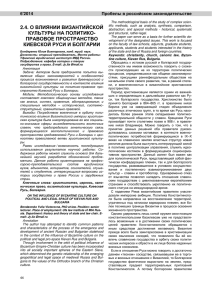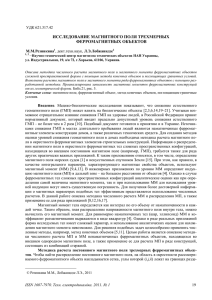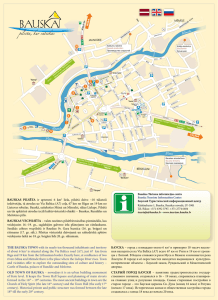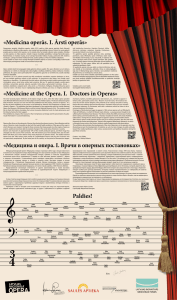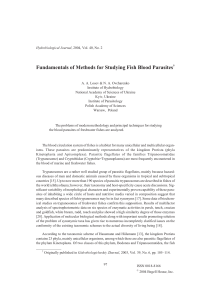cвятая русь - The Tretyakov Gallery Magazine
реклама
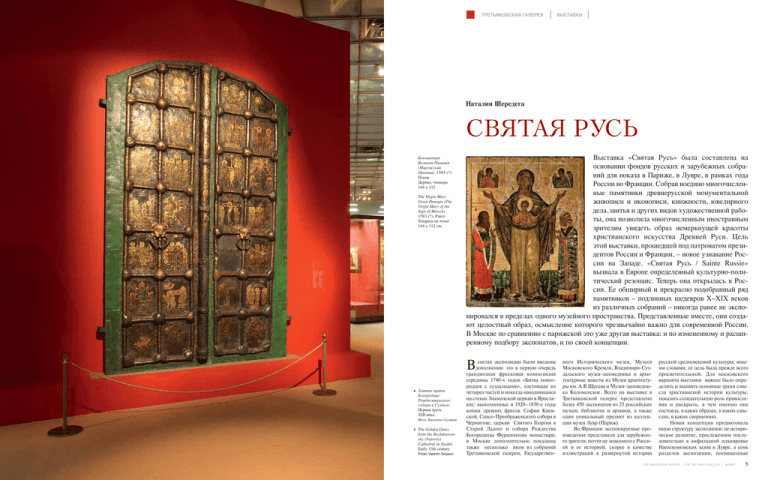
ТРЕТЬЯКОВСКАЯ ГАЛЕРЕЯ ВЫСТАВКИ Наталия Шередега CВЯТАЯ РУСЬ Богоматерь Великая Панагия (Мирожская Оранта). 1583 (?) Псков Дерево, темпера 144 × 112 The Virgin Mary Great Panagia (The Virgin Mary of the Sign of Mirozh) 1583 (?). Pskov Tempera on wood 144 × 112 cm Выставка «Святая Русь» была составлена на основании фондов русских и зарубежных собраний для показа в Париже, в Лувре, в рамках года России во Франции. Собрав воедино многочисленные памятники древнерусской монументальной живописи и иконописи, книжности, ювелирного дела, шитья и других видов художественной работы, она позволила многочисленным иностранным зрителям увидеть образ немеркнущей красоты христианского искусства Древней Руси. Цель этой выставки, прошедшей под патронатом президентов России и Франции, – новое узнавание России на Западе. «Святая Русь / Sainte Russie» вызвала в Европе определенный культурно-политический резонанс. Теперь она открылась в России. Ее обширный и прекрасно подобранный ряд памятников – подлинных шедевров X–XIX веков из различных собраний – никогда ранее не экспонировался в пределах одного музейного пространства. Представленные вместе, они создают целостный образ, осмысление которого чрезвычайно важно для современной России. В Москве по сравнению с парижской это уже другая выставка: и по измененному и расширенному подбору экспонатов, и по своей концепции. В Златые врата БогородицеРождественского собора в Суздале. Первая треть XIII века Фото: Валентин Скляров The Golden Gates from the Rozhdestvensky (Nativity) Cathedral in Suzdal. Early 13th century Photo: Valentin Sklyarov состав экспозиции были введены дополнения: это в первую очередь грандиозная фресковая композиция середины 1740-х годов «Битва новгородцев с суздальцами», состоящая из четырех частей и некогда находившаяся на стенах Знаменской церкви в Ярославле; выполненные в 1920–1930-е годы копии древних фресок Софии Киевской, Спасо-Преображенского собора в Чернигове, церкви Святого Георгия в Старой Ладоге и собора Рождества Богородицы Ферапонтова монастыря; в Москве дополнительно показаны также несколько икон из собраний Третьяковской галереи, Государствен- ного Исторического музея, Музеев Московского Кремля, Владимиро-Суздальского музея-заповедника и архитектурные макеты из Музея архитектуры им. А.В.Щусева и Музея-заповедника Коломенское. Всего на выставке в Третьяковской галерее представлено более 450 экспонатов из 25 российских музеев, библиотек и архивов, а также один уникальный предмет из коллекции музея Лувр (Париж). Во Франции экспонируемые произведения представали для зарубежного зрителя, почти не знакомого с Россией и ее историей, скорее в качестве иллюстраций к развернутой истории русской средневековой культуры; иными словами, ее цель была прежде всего просветительской. Для московского варианта выставки важнее было определить и выявить основные грани смысла христианской истории культуры, показать созидательную роль православия и раскрыть, в чем именно она состояла, в каких образах, в каких смыслах, в каких свершениях. Новая концепция продиктовала иную структуру экспозиции: не историческое развитие, прослеженное последовательно в анфиладной планировке Наполеоновских залов в Лувре, а семь разделов экспозиции, посвященные ТРЕТЬЯКОВСКАЯ ГАЛЕРЕЯ / THE TRETYAKOV GALLERY / #2’2011 5 THE TRETYAKOV GALLERY CURRENT EXHIBITIONS Natalya Sheredega HOLY RUS The Visual History of a Country’s Faith Андрей РУБЛЕВ (?) Богоматерь Владимирская Конец XIV – начало XV века. Москва Дерево, темпера 102,2 × 69,6 Andrei RUBLEV (?) Our Lady of Vladimir End of 14th – early 15th century. Moscow Tempera on wood 102.2 × 69.6 cm The “Holy Rus” exhibition, featuring items from Russian and international collections, was shown at the Louvre in Paris as part of the “Year of Russia in France”. Collecting many artefacts of ancient Russian monumental art and icon painting, book printing, jewellery, embroidery and other forms of artistic expression, it gave European viewers a chance to see the unfading beauty of the Christian art of ancient Rus (Ruthenia). Under the patronage of the presidents of Russia and France, its aim was to increase the European publicʼs knowledge of Russia. “Holy Rus/Sainte Russie” provoked a serious cultural and political response in Europe, and is now on view in the Tretyakov Gallery in Moscow until August 14. The superb works of art of the 10th-19th centuries from a large number of museums have never before been displayed within the same museum space. Brought together, they create a holistic image of statehood, one very important for contemporary Russia. The Moscow exhibition differs from its Parisian counterpart both because it shows more items, and because it conveys a different message. T Экспозиция Фото: Валентин Скляров View of the exhibition Photo: Valentin Sklyarov 6 he Russian show features objects not displayed in Paris, including, a grandiose four-piece 1740s fresco “Battle of the Novgorodians with the Suzdalians”, previously held at the Znamenskaya Church in Yaroslavl; copies, made in the 1920s-1930s, of ancient frescoes in the St. Sophia Cathedral in Kiev, the Spaso-Preobrazhensky (Transfiguration) Cathedral in Chernigov, the St. George Church in Staraya Ladoga, and the Cathedral of the Nativity of the Mother of God at the Ferapontov Monastery; several icons from the Tretyakov Gallery, Historical Museum, Museums of the Moscow Kremlin, the Open-Air Museum of the Cities of Vladimir and Suzdal, and architectural models from the Shchusev Museum of Architecture and the Kolomenskoe OpenAir Museum. Overall, the Tretyakov Gallery show includes more than 450 items from 25 Russian museums, libraries and archives, as well as one unique object from the Louvre in Paris. ТРЕТЬЯКОВСКАЯ ГАЛЕРЕЯ / THE TRETYAKOV GALLERY / #2’2011 In France, the display was seen by foreign viewers, who know relatively little about Russia and its history, mostly as illustrations to a comprehensive history of Russian medieval culture – in other words, the show’s mission was predominantly educational. The Russian exhibition, however, was more focused on identifying the main aspects of the meaning of the Christian history of culture, demonstrating the formative role of Orthodox Christianity and highlighting its content, imagery, messages, and achievements. The different concept dictated a different structure: instead of one historical narrative laid out across the enfilade of Napoleon’s rooms in the Louvre, seven sections of the exhibition in Moscow focus on different aspects of Russian medieval culture. For Russians, the images of Russia’s past must be “deciphered” to become clearer, more nuanced and more profound. Thus, the exhibition is sectioned into different parts: “Born in the Spirit. The Baptism of Rus and Introduction of the Christian Faith”, “Under the Protection of the Mother of God”, “Patrons and Mentors. Veneration of Saints in Rus and Russian Saints”, “The Light in the Wilderness. Monasteries in Rus”, “The Earthly Kingdom and the Heavenly Kingdom”, “Holy Objects in Everyday Life”, and “Heaven on Earth. Inside the Russian Christian Orthodox Church”. This grandiose project came together through the joint work of a large team of art scholars and designers, custodians and art renovators, multimedia specialists and coordinators. Dozens of hand-written books were scanned especially for the show, and authentic works of Russian culture of book production can be leafed through on computer screens. A new catalogue was published for the Russian show, and the structure of the Russian publication – the content of its main theoretical articles, written by leading experts on ancient Russian art – differs significantly from the publication for Paris. CURRENT EXHIBITIONS ВЫСТАВКИ Every section in the catalogue is supplied with an epigraph – several quotations from different medieval texts metaphorically conveying the message and content of the relevant section. The goal of this exhibition is to let Time speak for itself. Остромирово Евангелие 1056–1057 Киев или Новгород Пергамен, чернила, киноварь, темпера, золото 35,5 × 29 Юрьевское Евангелие 1119–1128 Киев или Новгород (?) Пергамен, чернила, киноварь 33,2 × 28 8 Ostromir Gospels 1056-1057 Kiev or Novgorod Ink, vermillion, tempera, gold on parchment 35.5 × 29 cm Yuriev Gospels 1119-1128 Kiev or Novgorod (?) Ink, vermillion on parchment 33.2 × 28 cm ТРЕТЬЯКОВСКАЯ ГАЛЕРЕЯ / THE TRETYAKOV GALLERY / #2’2011 1. BORN IN THE SPIRIT. THE BAPTISM OF RUS AND INTRODUCTION OF THE CHRISTIAN FAITH The first section of the display features fragments of murals from Ruthenia’s oldest churches – in Kiev, Staraya Ladoga, Ryazan, and Smolensk, as well as ancient manuscripts and icons showing the finest craftsmanship of the artisans working at the very earliest period of Ruthenian culture (before the occupation of Rus by the Tartars and Mongols), and convincingly demonstrating strong ties with Byzantium. The grandiose westward fire-gilt Golden Gates from the Rozhdestvensky (Nativity) Cathedral in Suzdal serves as the “gateway” to the exhibition. Manufactured in the early 13th century, the gate set out on its first ever journey only last year, first to the Louvre and now to Moscow. Among the 28 scenes from the life of Christ and the Mother of God (Theotokos) featured on the gate, the image of the Protection by the Mother of God – the earliest image of its kind among extant icons – is especially remarkable. Prince Andrei Bogolyubsky of Vladimir, who decreed that the day of the Protection by the Mother of God should become a feast day, is believed to have been linked to a unique item on display in Moscow which arrived from the Louvre. Its history is unusual and instructive: the armilla (shoulder shield) was an accessory of the prince’s ceremonial attire. Some scholars believe that it was created in the second half of the 12th century by Moselle artisans using the intricate techniques of champlevé and cloisonné on gilded brass; presumably, the piece was gifted by Frederick I Barbarossa to Andrei Bogolyubsky. The records state that the armilla was held at the Uspensky (Assumption) Cathedral in Vladimir since the 12th century until 1919, when it was transferred to a museum; in 1933 it was sold to an international buyer. In the autumn of 1934 the precious item was bought by the Society of Friends of the Louvre and presented to the museum as a gift. Like the armilla from the Louvre, most exhibits at the show are not only among the finest artefacts of medieval art but also took part in, and were witness to, certain landmark historical events. In 1805, sorting through Catherine II’s private belongings, the oldest dated handwritten book ever produced in Ruthenia was found, the famed Ostromir Gospels, created in 1056-1057. The text in the oldest altar Gospels is written in a semiuncial hand and decorated with precious initials, and the miniatures were probably made by craftsmen from Constantinople. The relics from Byzantium and the Holy Land help trace the routes by which religious docrine came to Rus, and the treasures from the ancient hoards and burial mounds, which include finely crafted objects of applied art and Byzantine and Western European coins and jewellery, point to close ties between Kievan Rus and other state entities. A special place at the show is occupied by the images of personalities from the early days of Russian Christianity, such as Vladimir I of Kiev (Vladimir Svyatoslavovich), the prince who baptised Rus, and St. Boris and St. Gleb, Ruthenia’s first canonised saints, as well as by a distinguished copy of the famed icon of the Mother of God of Vladimir (12th century), created at the turn of the 15th century, perhaps with the participation of Andrei Rublev. 2. UNDER THE PROTECTION OF THE MOTHER OF GOD The image of the Mother of God as the protector, interceder with God and special patroness of the nation was a permanent presence in Ruthenian literature and art. In Rus, a feast of the Protection of the Mother of God was introduced in the 12th century, and the year of 1165 saw the construction of the first church dedicated to the Protection – the famed Church of the Intercession on the River Nerl (Pokrova na Nerli). A fragment of its white-stone décor is placed next to the white-stone fragments of furnishings from the oldest Mother of God cathedrals in the Principality of Vladimir and Suzdal – the cathedral in Bogolyubovo dedicated to the Mother of God’s Nativity, built in 1165, the Uspensky (Assumption) Cathedral in Vladimir, built in 1160, and the Rozhdestvensky (Nativity) Cathedral in Vladimir, built in 1196. Numerous miracle-working icons and their copies are convincing evidence of the exceptionally reverential treatment accorded to the Mother of God in Rus: these include the “Theotokos Maximovskaya” (c. 1299-1305), commissioned by Metropolitan Maxim; “Theotokos of Tolga” (late 13th century); “Theotokos Pimenovskaya” (1480s), brought from Constantinople by Metropolitan Pimen; “Theotokos of Kazan” (1606); the 16thcentury Panhagia Platytera (the Mirozh Mother of God of the Sign), a copy of the old cherished icon from the Mirozhsky Monastery in Pskov. The icon “Theotokos the Unexpected Joy with the Icons of the Theotokos” (19th century) features representations of 120 venerated icons of the Mother of God around the central image. This icon is in essence an encyclopaedia of the Mother of God’s iconography, but its significance is of much more importance. The icon’s dogmatic meaning is conveyed through the central, big-sized image of the icon “Theotokos the Unexpected Joy”. The narrative is culled from the work “Fleece Bedewed” by St. Dimitry of Rostov разным сторонам русской средневековой культуры. Образ прошлого России для нас самих должен быть развернут отчетливее, подробнее, глубже. Разделы названы так: «Рождение в Духе. Крещение Руси и утверждение христианской веры», «Под Покровом Богородицы», «Заступники и наставники. Почитание святых на Руси и русские святые», «Свет в пустыне. Монастыри на Руси», «Земное царство и Царствие Небесное», «Святое в повседневном» и «Небо на земле. Русский православный храм». Над осуществлением этого грандиозного проекта трудился большой авторский коллектив – это искусствоведы и дизайнеры, хранители и реставраторы, координаторы и специалисты в области создания мультимедийного контента. Специально для этой экспозиции были отсканированы десять рукописных книг, и рядом с подлинными шедеврами древнерусской книжной культуры размещены мониторы, на которых в постоянном режиме «листаются» страницы уникальных манускриптов. Как и во Франции, к открытию выставки был издан каталог, однако его структура и состав главных теоретических статей, написанных ведущими специалистами в области древнерусского искусства, принципиально отличаются от парижского издания. Каждому разделу каталога предшествуют цитаты из различных средневековых источников, метафорически раскрывающие программу и содержание самостоятельных разделов. Здесь Время говорит само за себя. Наплечник. Воскресение Христово Ок. 1170–1180 Мозельская школа. Золоченая медь; выемчатая эмаль, перегородчатая эмаль 11,8 × 14,7 Лувр Shoulder-piece (Armilla). Ressurection of Christ Ca. 1170-1180 Moselle school Gilded copper; cloisonne enameling, champleve enameling 11.8 × 14.7 cm Louvre Суздальское оплечье XII – начало XIII века Медальоны: серебро; штамповка, золочение, резьба, чернь Suzdal Yoke-necklets (Suzdal Chain) 12th-early 13th c. Medallions: silver; chasing, carving, gilding, niello 1. РОЖДЕНИЕ В ДУХЕ. КРЕЩЕНИЕ РУСИ И УТВЕРЖДЕНИЕ ХРИСТИАНСКОЙ ВЕРЫ В первый раздел экспозиции вошли фрагменты росписи древнейших храмов Древней Руси – Киева, Старой Ладоги, Рязани, Смоленска, а также рукописи и иконы, свидетельствующие о высочайшем художественном уровне самого раннего, «домонгольского» периода древнерусской культуры и, несомненно, об активных контактах с Византией. Грандиозные западные Золотые врата из Рождественского собора Суздаля, исполненные в технике «огневого золочения», по сути являются «вратами», открывающими выставку. Созданные в начале XIII столетия, они совершили свое первое путешествие только в прошлом году – на выставку в Лувр, а затем – в Москву. Среди 28 сцен христологического и богородичного циклов, расположенных на створках врат, особого внимания заслуживает изображение Покрова Богородицы – самого раннего из дошедших до нашего времени. С именем владимирского князя Андрея Боголюбского, при котором было установлено празднование Покрова Богородицы, связывают уникальный экспонат, прибывший на выставку в Москву из Лувра. История его бытования необычна и поучительна. Наплечник (armilla) являлся частью парадного княжеского облачения. По мнению исследователей, он был создан во второй половине XII столетия мастерами Мозельской школы в сложнейшей технике выемчатой и перегородчатой эмали на золоченой меди и, предположительно, подарен императором Фридрихом Барбароссой Андрею Боголюбскому. Документально известно, что с XVII века наплечник находился в Успенском соборе Владимира, в 1919 году был передан в музей, а в 1933 году в период распродаж произведений искусства он попал за границу. Осенью 1934 драгоценный предмет был выкуплен Обществом друзей Лувра и подарен музею. Большинство экспонатов выставки, как и луврская армилла, – не только блестящие образцы средневекового искусства, но вместе с тем участники и свидетели великих исторических событий самых разных периодов. В 1805 году при разборе личных вещей Екатерины II была найдена самая ранняя датированная древнерусская рукописная книга – знаменитое Остромирово Евангелие, созданное в 1056–1057 годах. Текст напрестольного Евангелия написан полууставом, украшен драгоценными инициалами, а миниатюры, вероятно, выполнены константинопольскими мастерами. Реликвии Византии и Святой Земли свидетельствуют о том, откуда и как приходило на Русь вероучение, а сокровища древних кладов и курганов, в которых находились исключительные по мастерству исполнения произведения декоративно-прикладного искусства, византийские и западноевропейские монеты и ювелирные изделия – о широких связях Киевской Руси с различными странами. Особое место в экспозиции уделено образам начальной истории русского христианства: Святого князя Владимира – крестителя Руси и ТРЕТЬЯКОВСКАЯ ГАЛЕРЕЯ / THE TRETYAKOV GALLERY / #2’2011 9 CURRENT EXHIBITIONS ВЫСТАВКИ 3. PATRONS AND MENTORS. VENERATION OF SAINTS IN RUS AND RUSSIAN SAINTS Christianity is presented not only in texts but in images as well. The images of Russian sainthood are the most profound, intimate and warm images that ever existed in the country’s history. The lives of Ruthenia’s first canonised saints Boris and Gleb was included into the famous Sylvester Manuscript (14th century), which contains 40 miniatures relating their spiritual exploits. Icon painters too tackled the lives of the saints, depicting them, in agreement with the canon, either mounted on horses, or standing and facing the viewer directly. The host of Russian saints, begun with the canonisation of Boris and Gleb, was steadily expanding. The ideal of Russian sainthood largely originated from the ideal of Byzantine asceticism and was depicted not only in icons but in frescoes, miniatures and even wooden statues as well. The examples of woodwork featured at the show include two carved lids of the tombs of St. Ioann the Archbishop of Novgorod, and St. Anthony of Rome, manufactured in the 16th-17th centuries and previously held at the Sophia Cathedral in Novgorod. It should be mentioned that the reliefs became museum artefacts as early as the 18th century, when, after a 1722 directive issued by the Synod that prohibited sculpture in churches, they were removed from the sepulchres and replaced with paintings, and later were transferred to the Imperial Academy of Fine Arts. Another rare piece of woodcarving is “St. George and the Dragon” (second half of the 16th century). The known images of St. George, who was revered in Ruthenia on the same level as St. Nicholas (St. Nikolas of Myra), St. Demetrius of Thessaloniki (Dimitry Solunsky), St. Blaise, Bishop of Sebastia (Vlasy Sevastiisky), and St. Spyridion, Bishop of Trimythous (Spyridon Trimifuntsky), include not only representations of the dragon-killing episode but also icons with scenes from his life. The most worshipped female saints included St. Paraskevi of Iconium, Anastasia and, especially, St. Barbara, whose relics were brought from Byzantium to Kiev as early as the 12th century. (written in Chernigov in 1863) – the story of a sinner planning to commit a villainy who prays before an icon of the Theotokos, and the bleeding wounds open on the body of the baby Christ. But the Theotokos begs Christ to be merciful and forgive even such sinners. The icons “Assumption of the Theotokos” and “Protection by the Theotokos” are devoted to the holy feasts celebrating the Mother of God: the diverse hymnic texts with lots of expansive poetic and symbolic epithets gave rise to such images as “In Thee Rejoiceth”, “Unfading Bloom”, “Theotokos the 10 Orchard” and others. The narrative of the icon “Miracle Wrought by the Theotokos of the Sign”, also known as “Battle of the Novgorodians with the Suzdalians”, is drawn from a legend about the icon “Theotokos of the Sign” which miraculously delivered the city of Novgorod the Great from a besieging army of the Principality of Suzdal in 1170. The colossal mid18th-century fresco from the Znamensky Church in Yaroslavl offers an original interpretation of this rare iconic type which is related mostly to the culture of Novgorod the Great. ТРЕТЬЯКОВСКАЯ ГАЛЕРЕЯ / THE TRETYAKOV GALLERY / #2’2011 Чудо святого Георгия о змие Вторая четверть XV века. Новгород Дерево, темпера 58,5 × 42 St. George and the Dragon Second quarter of the 15th century. Novgorod Tempera on wood 58.5 × 42 cm 4. THE LIGHT IN THE WILDERNESS. MONASTERIES IN RUS In the vast and ever expanding Christian state, monasteries, the centres of its spiritual enlightenment, were also its defence, protective outpost and banner, minor representations of the City of God on earth. That was how they were built and decorated and how they aspired to live. This section features images of the founders of the distinguished Russian convents – St. Sergius of Radonezh, Demetrius the Wonderworker of Priluky (Dimitry Prilutsky), Zosimas the Abbot of Solovky (Zosima Solovetsky), Sabbatius Андрей РУБЛЕВ Святая Троица 1425–1427 Дерево, темпера 142 × 114 Andrei RUBLEV The Holy Trinity 1425-1427 Tempera on wood 142 × 114 cm Оклад иконы «Святая Троица» письма Андрея Рублева Конец XVI века; 1754 Cover of the icon of “The Holy Trinity” by Andrei Rublev End of 16th century; 1754 Святых Бориса и Глеба – первых русских канонизированных святых, а также чтимому списку прославленной иконы Богоматери Владимирской (XII век), созданному на рубеже XIV и XV веков, возможно, при участии Андрея Рублева. 2. ПОД ПОКРОВОМ БОГОРОДИЦЫ Образ Богоматери как защитницы, заступницы и особой покровительницы страны постоянно присутствует в литературе и искусстве Древней Руси. Именно на Руси в XII веке был установлен праздник Покрова Божией Матери и в 1165 году воздвигнут первый Покровский храм – знаменитая церковь Покрова на Нерли. Фрагмент ее белокаменного декора соседствует с белокаменными деталями убранства древнейших соборов Владимиро-Суздальской Руси, посвященных Богоматери – храма Рождества Богородицы в Боголюбове 1165 года, Успенского собора во Владимире 1160 года, Рождественского собора во Владимире 1196 года. Многочисленные свидетельства исключительного почитания Богоматери на Руси – ее чудотворные иконы и списки с них, среди которых Богоматерь Максимовская (около 1299– 1305), написанная по заказу митрополита Максима, Богоматерь Толгская (конец XIII в.), Богоматерь Пименовская (80-е годы XIV в.), привезенная из Константинополя митрополитом Пименом, Богоматерь Казанская (1606), Богоматерь Великая Панагия (Оранта Мирожская) XVI века, являющаяся списком с древней святыни Мирожского монастыря в Пскове. В иконе «Богоматерь Нечаянная радость с иконами Богоматери» (XIX в.) вокруг центрального образа расположены изображения 120 чтимых Богородичных икон. Эта икона по сути является своеобразной энциклопедией богородичной иконографии, однако этим ее значение не исчерпывается. Догматический смысл выражен в центральном, выделяющемся большим размером образе иконы «Богоматерь Нечаянная радость». Сюжет почерпнут из сочинения святителя Дмитрия Ростовского «Руно орошенное» (Чернигов, 1683), в котором повествуется о грешнике, задумавшем совершить злодеяние и молившемся перед иконой Богоматери, отчего на теле младенца Христа открылись раны и потекла кровь. Богоматерь же умоляет Христа быть милостивым и простить даже таких грешников. Праздникам в честь Богоматери посвящены иконы «Успение Богоматери» и «Покров Богоматери»; разнообразные гимнографические тексты, изобилующие развернутыми поэтическими и символическими эпитетами, стали основой для таких образов, как «О тебе радуется», «Неувядаемый цвет», «Богоматерь Вертоград Заключенный» и Икона-складень наперсная 1411–1412 годы Москва Серебро, жемчуг; литье, чеканка, резьба, чернь, золочение 9,5 × 6,5 × 1,3 Folding Pectoral Icon 1411-1412 Moscow Silver, pearls; casting, chasing, carving, niello, gilding 9.5 × 6.5 × 1.3 cm ТРЕТЬЯКОВСКАЯ ГАЛЕРЕЯ / THE TRETYAKOV GALLERY / #2’2011 11 CURRENT EXHIBITIONS the Miracle-worker of Solovky (Savvaty Solovetsky), Cyril of Belozersk (Kirill Belozersky), Alexander of Svir (Alexander Svirsky), Barlaam of Khoutyn, as well as manuscripts with their vitae. The icon “Vision of John Climacus” (late 16th-early 17th centuries) features 30 steps of spiritual ascent as a monk’s road to sainthood. In addition to icons, other items on view in this section include hand-written books with hand-painted miniatures and pieces of gilt-thread embroidery made at the monasteries. 5. THE EARTHLY KINGDOM AND THE HEAVENLY KINGDOM No matter how big a divide there was between the authorities and the sainthood throughout Ruthenian history, the image of holy state power was needed both as the ultimate goal and as a given reality. The vital topic of the relationship between the church and the state in Rus from the age of the principalities to the reign of Alexis of Russia (Alexei Mikhailovich) and Peter the Great, including the history of the synods and the schism (raskol) in the Russian Orthodox Church, is conceptualized through documents, manuscripts, icons, objects of applied art, and items used in liturgies. The tsars’ numerous endowments to the monasteries and churches were evidence of the Russian monarchs’ personal piety and highly reverential attitude to Christian relics. The process of manufacturing a precious frame for Russia’s most revered icon “The Holy Trinity”, created in the early 15th century by Andrei Rublev, extended over several centuries; commissioned by several Russian monarchs, from Boris Godunov to Mikhail I Fyodorovich Romanov, the piece was completed in the 18th century, with financing from the Holy Trinity – St. Sergius Lavra. The Cathedral of the Archangel in the Moscow Kremlin served as the burial ground for a succession of Russian monarchs up to Peter the Great. The cathedral once held all the most famous sepulchral icons of the ruling family, including the precious lid of the reliquary with the remains of Ivan the Terrible’s youngest 12 ВЫСТАВКИ son Tsarevich Dmitry, whose murder was once imputed to Boris Godunov, and the picture from the tomb of Grand Prince Vasily III, the father of Ivan the Terrible. The icon “Devotion to the Cross” from the Teremnoi Palace of the Moscow Kremlin images Tsar Alexis and Tsarina Maria Ilyinichna (Miloslavskaya). On a commission from Tsarevna Sophia Alexeyevna, an artisan from the Armoury Chamber Ivan Saltanov created in 1686 a sepulchral portrait of the prematurely deceased Tsar Fyodor Alexeyevich. The grandiose parsuna (a transitional kind of image between an icon and a portrait) “Patriarch Nikon with the Brethren of the New Jerusalem (Voskresensky) Monastery” (1660-1665) depicts the sullen appearance of one of the chief originators of the tragedy of the schism in the Russian Orthodox Church. The valuable panagia (an icon of the Theotokos facing the viewer directly) featured in this parsuna on the Patriarch’s breast is also on view at the show. The awesome and dramatic history of the Russian Orthodox Church is reflected in documentary records – from the 1590 letter of the Constantinople Council authorizing the establishment of the Patriarchate in Moscow to the Spiritual Regulation issued by Peter the Great. 6. HOLY OBJECTS IN EVERYDAY LIFE Life consists of years, months and days, which, in a Christian Orthodox mind, are sanctified with a cyclical succession of feasts, with the church calendar, prayers on occasions of the feasts, everyday prayers and even, as the ideal of sainthood would have it, non-stop prayers. From birth to death, an Orthodox Christian lived with religious objects of everyday use, such as baptismal crosses worn on the neck, reliquaries, folding icons for domestic use and for use when traveling, books for reading at home, and graveside crosses symbolising hope for the forthcoming resurrection. There are many surviving art objects manufactured by Ruthenian craftsmen for use by Christians in everyday life: from the 12th-century records, ТРЕТЬЯКОВСКАЯ ГАЛЕРЕЯ / THE TRETYAKOV GALLERY / #2’2011 Складень-иконостас Первая треть XVII века Строгановские мастерские Дерево, серебро, камка; темпера, чеканка, золочение, ткачество 31,5 × 13,5 × 2,4 Folding Iconostasis First third of 17th c. Stroganov workshop Wood, silver, damask; tempera, chasing, gilding, weaving 31.5 × 13.5 × 2.4 cm made on pieces of birch bark, about the commissioning of icons for a church, to a set of icons from the iconostasis over Tsarevna Sophia Alexeyevna’s grave in the Smolensky Cathedral of the Novodevichy Convent. Iconostases for graves included icons that had accompanied the deceased Christian throughout his or her life, beginning from the “life-size” icon approximating the size of the newborn and ending with the “graveside” icon placed on the dead person’s coffin. Sometimes icons were presented as a gift on the occasion of a name day, while at other times icons were commissioned. Most icons from Tsarevna Sophia’s sepulchral iconostasis were manufactured by artisans from the Armoury Chamber and set with precious stones. 7. HEAVEN ON EARTH. INSIDE THE RUSSIAN CHRISTIAN ORTHODOX CHURCH The house of worship is the ultimate image of Orthodox Christianity. This is the hub of all aspirations of mortal life, the place of transformation prior to one’s entry into the heavenly world; this is where the unfading joy of the light of Christ and the inexhaustible truth of the liturgy are to be found. Objects used in decoration of Christian Orthodox houses of worship (churches, cathedrals) and during divine services have complex symbolic meanings revealed during the sacraments: these items include an iconostasis separating the altar from the rest of the church, icons on columns and walls, liturgical implements, vestments and books. The exhibition presents 13 icons from an iconostasis produced in 1497 for the Uspensky (Assumption) Cathedral of the St. Cyril of Belozersk (Kirillo-Belozersky) Monastery – the images belonged to the Deesis, Feasts and Prophets tiers. The liturgical utensils and vessels on display include a jasper chalice manufactured in 1329 on a commission from Archbishop Moses, a plate donated to the Cathedral of the Archangel in the Moscow Kremlin in remembrance of Tsar Fyodor Ioannovich, and cups for blessing the water. The других. Сюжет иконы «Чудо от иконы Богоматерь Знамение», известной также под названием «Битва новгородцев с суздальцами», основан на предании об иконе «Богоматери Знамение», чудесным образом оказавшей помощь Новгороду при его осаде суздальскими войсками в 1170 году. Своеобразная интерпретация этого редкого иконографического типа, связанного в основном с культурой Новгорода, предстает в грандиозной фресковой композиции середины XVIII века из Знаменской церкви Ярославля. 3. ЗАСТУПНИКИ И НАСТАВНИКИ. ПОЧИТАНИЕ СВЯТЫХ НА РУСИ И РУССКИЕ СВЯТЫЕ Христианство явлено как в своих текстах, так и в ликах. Образы русской святости – глубочайшие, сокровенные и самые теплые в нашей истории. Житие первых русских канонизированных святых Бориса и Глеба вошло в состав знаменитого Сильвестровского сборника (XIV век), который сопровождается сорока миниатюрами, повествующими об их духовном подвиге. Герои этого повествования предстают и в иконах, в которых, согласно канону, они изображались или как всадники, или стоящими прямолично. Пантеон русских святых, начало которому положила канонизация Бориса и Глеба, постоянно расширялся. Идеал русской святости во многом опирался на идеал византийского подвижничества и был зримо явлен не только в иконах, но и во фресках, миниатюрах и даже в деревянной скульптуре. На выставке представлены два деревянных рельефа XVI–XVII веков, происходящие из Софийского собора Новгорода, которые являются крышками гробниц святого Иоанна, архиепископа Новгородского, и святого Антония Римлянина. Интересно, что они приобрели музейный статус еще в XVIII веке, когда после синодального Указа 1722 года о запрете скульптуры в храмах они были сняты с гробниц и заменены на живописные изображе- ния, а впоследствии попали в музей Императорской Академии художеств. К числу редких произведений деревянной резьбы относится и «Чудо Георгия о змие» (вторая половина XVI в.). Почитаемый на Руси наряду со святыми Николаем Мирликийским, Дмитрием Солунским, святителями Власием Севастийским и Спиридоном Тримифунтским, святой Георгий изображался не только поражающим змия, но и в житийных иконах. Среди святых жен наряду с Параскевой и Анастасией особо почиталась святая Варвара, мощи которой еще в XII веке были перевезены из Византии в Киев. 4. СВЕТ В ПУСТЫНЕ. МОНАСТЫРИ НА РУСИ Монастыри в необъятной и все расширяющейся христианской стране были центрами духовного просвещения, ее обороной, форпостом и знаменем, малыми образами Града Божия на земле. Такими они строились, так они украшались, так стремились жить. В составе этого раздела можно видеть образы основателей прославленных русских обителей – преподобных Сергия Радонежского, Дмитрия Прилуцкого, Зосимы и Савватия Соловецких, Кирилла Белозерского, Александра Свирского, Варлаама Хутынского, рукописи с текстами их житий. В иконе «Видение Иоанна Лествичника» (конец XVI – начало XVII веков) изображены 30 ступеней духовного восхождения, как монашеский путь достижения святости. Помимо икон, этот раздел экспозиции демонстрирует рукописные иллюминированные книги и золотное шитье, созданные в стенах монастырей. 5. ЗЕМНОЕ ЦАРСТВО И ЦАРСТВИЕ НЕБЕСНОЕ Как бы ни расходились в истории Руси пути власти и пути святости, образ святой власти был необходим и как высшая цель, и как зримая реальность. Важнейшая тема отношений русской церкви и русской государственности от княже- ского периода до времени правления Алексея Михайловича и Петра I, история соборов и Раскола осмыслены через документы, рукописи, иконы и предметы декоративно-прикладного искусства, богослужебные предметы. Многочисленные царские вклады в монастыри и церкви свидетельствовали о личном благочестии русских государей, об особом почитании ими святынь. Драгоценный убор самой почитаемой на Руси иконы «Святая Троица», написанной в начале XV века Андреем Рублевым, создавался на протяжении столетий по заказу нескольких поколений русских правителей от Бориса Годунова до Михаила Романова, а завершен был в XVIII веке на средства Троице-Сергиева монастыря. Архангельский собор Московского Кремля служил усыпальницей русских государей вплоть до Петра I. Именно оттуда происходят все самые знаменитые надгробные иконы царской семьи, в том числе драгоценная крышка раки младшего сына Ивана Грозного царевича Димитрия, в убийстве которого обвиняли Бориса Годунова, и надгробный образ великого князя Василия III – отца Ивана Грозного. В иконе «Поклонение Кресту» из Теремного дворца Московского Кремля предстают царь Алексей Михайлович и царица Мария Ильинична. По заказу царевны Софьи в 1686 году мастером Оружейной палаты Иваном Салтановым был написан надгробный портрет рано умершего царя Федора Алексеевича. В парсуне «Патриах Никон с братией Воскресенского Ново-Иерусалимского монастыря» (1660–1665 гг.) – суровый облик одного из главных творцов трагической истории русского церковного Раскола. Драгоценную Панагию, изображенную в этой парсуне на груди Патриарха, можно видеть среди экспонатов выставки. Величественная и драматическая история русской православной церкви отражена в документальных свидетельствах – от грамоты 1590 года Константинопольского собора об основании Московского патриархата до Духовного регламента Петра I. 6. СВЯТОЕ В ПОВСЕДНЕВНОМ Жизнь состоит из лет, месяцев и дней, и они в православном сознании освящены циклической последовательностью праздников, церковным календарем, молитвой праздничной, ежедневной и даже – в идеале святости – непрерывной. Жизнь православного христианина от рождения до смерти сопровождали вошедшие в обиход нательные кресты, мощевики-реликварии, домашние и походные иконостасы-складни, книги для домашнего чтения, намогильные кресты, символизирующие надежду на грядущее Воскресение. Искусство Древней Руси сохранило множество предметов част- ТРЕТЬЯКОВСКАЯ ГАЛЕРЕЯ / THE TRETYAKOV GALLERY / #2’2011 13 CURRENT EXHIBITIONS ВЫСТАВКИ Саккос Ок. 1665 Сольвычегодск Мастерская Анны Ивановны Строгановой Холст, темпера 132 × 124 Sakkos. C. 1665 Solvychegorsk Workshop of Anna Ivanovna Stroganova Canvas, tempera 132 × 124 cm liturgical cuffs featuring a Deesis (12th century), which presumably belonged to Barlaam (Varlaam) of Khoutyn, are the oldest surviving of their kind. The ceremonial garb of Metropolitan Jonah (Iona) Sysoevich, created at the Stroganov workshops in 1665, is distinguished by the finest craftsmanship. The gospels, psalters and other unique hand-written worship books of the 14th-15th centuries illuminated with the miniatures are of particur interest. All these artefacts produce a visually compelling, tangible image of Holy Rus – the Christian Rus that keeps itself pious and clean, the Rus of ascetics and men of prayer, the Rus of God-loving monarchs who viewed their tsardom as the prefiguration of, and the gateway to, the Kingdom of Heaven. Held up against the facts, Holy Rus appears as a state with a really tragic past – the past marred by persecution of saints and destruction of cities, by fratricidal warfare and state crimes, and by the everyday imperfection of the human beings and disorder. However, observing the historical and cultural artefacts brought together at the exhibition, one becomes convinced that there has existed, to this day, Holy Rus, the Russia of Christian Orthodox tradition, the Russia of the Faith and Holiness, the Russia of monasteries, ascetics and men of prayer, the Russia beloved by the Mother of God and glorified by the Light of Truth. Every country has its ideal and ideal image, often distanced from its real history, but for that very reason clear and sublime. The exhibition is yet another opportunity to see this solemn, profound and majestic image – to see it not as something far distant, but in actual deeds, in creativity and incorruptible beauty. 14 ТРЕТЬЯКОВСКАЯ ГАЛЕРЕЯ / THE TRETYAKOV GALLERY / #2’2011 Патриарх Никон с братией Воскресенского Новоиерусалимского монастыря 1660–1665 Холст, масло 234 × 180 Patriarch Nikon with the Brethren of the New Jerusalem Monastery of the Resurrection 1660-1665 Oil on canvas 234 × 180 cm Святой Никола, с Деисусом и избранными святыми Первая половина XVI века Русский Север Дерево, темпера 62,5 × 50,5 St. Nicholas with Deesis and Selected Saints First half of 16th c. Russian North Tempera on wood 62.5 × 50.5 cm ТРЕТЬЯКОВСКАЯ ГАЛЕРЕЯ / THE TRETYAKOV GALLERY / #2’2011 15 CURRENT EXHIBITIONS ВЫСТАВКИ Чудо Святого Георгия о Змие Вторая половина XVI века Дерево, резьба, золочение, темпера 64,5 × 57,3 × 9,2 St. George and the Dragon Second half of 16th c. Wood, carving, gilding, tempera 64.5 × 57.3 × 9.2 cm ной жизни христианина: от берестяных грамот XII века, где говорится о заказе икон для храма, до комплекса икон из надгробного иконостаса царевны Софьи в Смоленском соборе Новодевичьего монастыря. В состав подобных входили иконы, сопутствовавшие христианину всю жизнь – начиная от «мерной» иконы, высота которой соответствовала росту новорожденного, до «гробовой», сопровождавшей гроб усопшего. Ряд из них мог быть получен как подарок по случаю именин или написан по специальному заказу. Большинство икон из надгробного иконостаса царевны Софьи было исполнено мастерами Оружейной палаты и украшено драгоценными окладами. 7. НЕБО НА ЗЕМЛЕ. РУССКИЙ ПРАВОСЛАВНЫЙ ХРАМ Самый высший образ православия – это храм. Здесь средоточие всех стремлений земной жизни и преображение их на пороге мира горнего; здесь немеркнущая радость света Христова и неиссякаемая истина Литургии. Предметы, входящие в комплекс убранства православного храма и участвующие в богослужениях, обладают сложным символическим смыслом, раскрывающимся во время службы: это иконостас, отделяющий алтарь от остального пространства храма и иконы, расположенные на столбах и стенах, литургические предметы, богослужебные одежды и книги. Иконостас Успенского собора Кирилло-Белозерского монастыря, исполненный в 1497 году, представлен 13 иконами, некогда входившими в состав Деисусного, праздничного и пророческого рядов. Среди литургической посуды и сосудов – яшмовый потир, сделанный в 1329 году по заказу архиепископа Моисея, тарель, вложенная в Архангельский Собор Московского Кремля в память о царе Федоре Ивановиче, водосвятные чаши. Рядом с ними поручи с изображением Деисуса (XII в.), принадлежавшие, по преданию, Святому Варлааму Хутынскому, являются самыми древними из дошедших до нашего времени. Высочайшим совершенством отмечены торжественные одеяния митрополита Ионы Сысоевича, 16 ТРЕТЬЯКОВСКАЯ ГАЛЕРЕЯ / THE TRETYAKOV GALLERY / #2’2011 Богоматерь Нечаянная Радость, с чудотворными иконами Богоматери Первая половина XIX века Дерево, темпера 121 × 94 Theotokos the Unexpected Joy with the Icons of the Theotokos First half of the 19th c. Tempera on wood 121 × 94 cm созданные в Строгановских мастерских в 1665 году, Евангелия, Псалтири и другие уникальные богослужебные рукописные книги XIV–XV веков, украшенные миниатюрами. Так составляется наглядный и зримый, вещественный образ Святой Руси – Руси православной, хранящей себя в благочестии и чистоте, Руси подвижников и молитвенников, Руси боголюбивых государей, мысливших свое царство как прообраз и преддверие Царствия Небесного. В своей летописной, хронологической истории Святая Русь предстает государством с резкими гранями трагического прошлого, омраченного преследованием святых и разорением городов, братоубийственными войнами и государственными преступле- ниями, повседневным человеческим несовершенством и неустройством. Однако при взгляде на собранные на выставке воедино памятники истории и культуры становится очевидным, что была и есть Святая Русь, Россия православной традиции, Россия церкви и святости, Россия монастырей, подвижников и молитвенников, Россия, любимая Божией матерью и прославленная светом Истины. Каждая страна имеет свой идеал и идеальный образ, часто далекий от ее исторической действительности, но благодаря этому – незамутненный и возвышенный. Выставка дает возможность увидеть торжественный, глубокий и величавый образ не в отвлеченной дали, но в живых деяниях, в творчестве и нетленной красоте. ТРЕТЬЯКОВСКАЯ ГАЛЕРЕЯ / THE TRETYAKOV GALLERY / #2’2011 17
